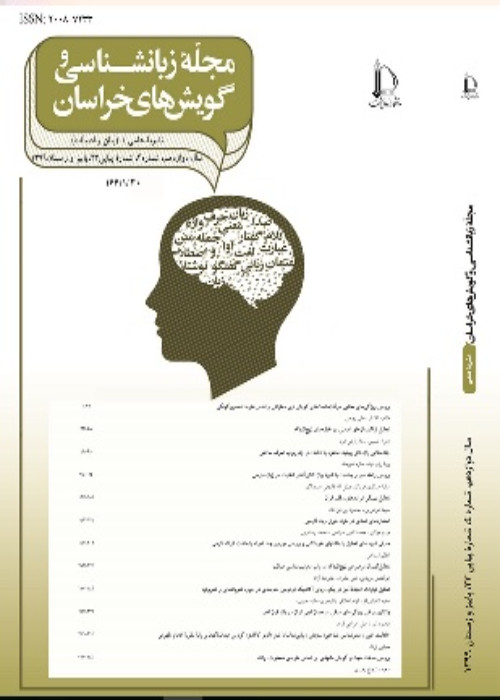A Functional-Typological Approach to Perfect Constructions in Persian
This article is an attempt to illustrate a comprehensive functional-typological study of two perfect constructions in modern Persian. In regard to these forms, there has been a kind of intricate complexity and difficulty that have occupied the minds of the grammarians and linguists. Regarding the complexity of the perfect constructions, what can be seen is the consistency and heterogeneity of these constructions with the past, on the one hand, and with the present, on the other hand, as well as the characteristics of tense and aspect, and their functions with adverb expressions. In addition, since the nature of the sentences are not directly determined by grammatical tenses, the various features of textual, linguistic, and meta-linguistic features play a great role in this regard. Accordingly, the motivation for writing this essay is to provide an explanation of the various aspects and functions of the present perfect and present perfect progressive in the contemporary Persian language, especially since their uses are widespread in their entirety compared with other perfect structures so that we can assume present perfect "the prototype" of these constructions. Therefore, we provide an explanation of these two perfect constructions, whose common elements are the past stem of the main verb plus the perfect aspect morpheme –e-, or the so-called “past participle. Also, the amalgamation of present perfect with the past tense, and its relation with definity, on then one hand, and the behavior of temporal adverbs towards the limitation of the perfect uses, along with aspectual and temporal nature of this construction and other perfect constructions as well as their relationship with the category of evidentiality on the other hand, have made this research more impressive.
This paper is conducted based on the framework of the functional-typological approach. In this approach, the structure of language depends on its role, in particular the role of communication. In other words, the most prominent principle in this approach is that the fundamental purpose of language is communication between human beings, and this role forms the structures in which the languages take. The claim of the role-oriented views is that, since language is a tool from the foundation, it is wise to think that language structures are best suited to refer to roles that they accept. Givon (2001, 293-297) puts forward that language and grammar are neither explained nor described as a separate device. He considers perfect structures the most complex and delicate categories in grammar. This linguist considers language a direct reflection of the human communication needs. He considers perfect constructs for an event that either occurred before a point of reference or at least before the speech time. He believes that perfect aspect is the most complicated grammatical category, giving it four characteristics of anteriority, perfectivity, counter-sequentiality and lingering relevance. A number of other authors also take benefit of the views of linguists such as Comrie (1976) and (1989), Bybee et al. (1994), Kyparsky (2002), Aikhenwald (2004), Vanvalin (2005), Duhan (2011), Craft (2012), and Haddlestone (2012, 1984).
To attain the goal of the study, the present authors have taken benefit from the application of functional-typological approach. The research data is collected mainly from current spoken Persian texts together with the content of television series, movies, talk shows, newspapers, periodicals, and in particular, the Bijankhan linguistic corpus, as well as classical Persian literature, in some cases, to support the claims. After evaluating the data, based on the phonetic, morpho-syntactic, semantic, and pragmatic criteria, the functions of the four perfect constructions are presented one by one, and their relationship with tense and aspect is presented. Also, the relationship between the evidentiality and the perfect constructions is determined.
In this paper the authors focused on two perfect constructions in Persian and tried to find out their tense and aspect relations, along with their different functions. As to the nature of tense or aspect regarding perfect constructions, it is concluded that, contrary to the claims of the grammarians and some linguists that placed these structures in the tense category, one can not draw the boundary between the two because both the nature of tense and nature of aspect can be seen in these constructions. Regarding the functions of the perfect constructions discussed in Farsi, it can be argued that for the present perfect, at least the functions of current relevance, hot news, resultative, experiential, mirativity, expression of the future event, tense projection, and dependence on the present and the past, for the present perfect progressive, as a combination of past and past continuous tense, functions of continuity, repetition, and habituation and evidentialty, and for the past perfect, actions preceding the past, the occurrence without precedence over the past, the continuous functioning and expression of the future can be mentioned. In addition, in the case of present perfect progressive, especially the first person and the second person do not have much use, and regarding the relationship between the two constructions and the category of evidentiality, it has been shown that both constructions show the function of the evidentiality. Furthermore, present perfect in the Persian language is one of the controversial grammatical constructs and is complex in terms of both form and semantics. In measuring other perfect structures, this construction is one of the most prominent grammatical categories: on the one hand, it relates to the past, and on the other hand, to the present. In addition, the reason why this complexity should be searched is for this feature, which can be used to construct a transcendental past to the entire period of time we talk about or link to any part of it.
In this paper, in the framework of the functional-typological approach and with the help of formal, phonetic, historical, semantic, applied, and function criteria, we have studied the functions of the present perfect, including indirect information or evidentiality, tense projection, resultative, hot news, and mirativity in Farsi, and discussed its behavior in relation to the tense, on the one hand, and to the past tense, on the other hand. We have also found out that the feature of current relevance locates on the top part of a hierarchical structure of present perfect functions and entails other functions. Regarding present perfect progressive, we came to this point that evidentiality is the most important function this form is used for in modern Persian.
- حق عضویت دریافتی صرف حمایت از نشریات عضو و نگهداری، تکمیل و توسعه مگیران میشود.
- پرداخت حق اشتراک و دانلود مقالات اجازه بازنشر آن در سایر رسانههای چاپی و دیجیتال را به کاربر نمیدهد.



